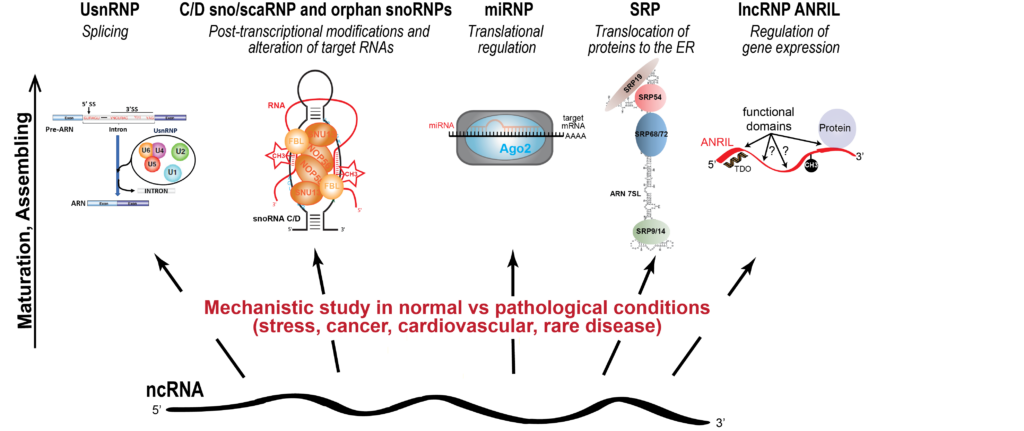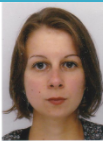Leaders:
B. CHARPENTIER
X. MANIVAL
Welcome to the dedicated page for our molecular biology and RNA research team. Our scientific activity focuses on the fundamental molecular mechanisms underlying cellular biology, with a particular emphasis on RNA components. With several decades of experience, our team is recognized for its significant contributions in areas such as RNA maturation, post-transcriptional modification of RNA, and the biogenesis of RNA-protein complexes, also known as Ribonucleoproteins (RNPs).
The distinctiveness of our work lies in our multidisciplinary approach. We employ a range of techniques, including genetic screening and linkage analyses, transcriptomics, proteomics, molecular genetics, cellular and molecular biology, biochemistry, and atomic-scale structural studies. Recently, we have expanded our activities to include clinical studies, collaborating with local health projects such as RHU FIGHT-HF and LUE IMPACT Geenage. We have also invested in the valorization of our fundamental research data, leading to pre-maturation projects in collaboration with SATT SAYENS, some of which have resulted in patents or are in the process of being patented ([]).
Our team is a member of the thematic group sifrARN (Structure, Integration, Function, and Reactivity of RNA) within the French Society of Biochemistry and Molecular Biology (SFBBM) and is a participant in the GDR RNA (Research Group 2083) ‘RNA as a tool and a target for medicinal chemistry and chemical biology.’ Additionally, we are an integral part of the ProteinLorraine network, bringing together a dozen laboratories affiliated with six scientific poles at the University of Lorraine.
Currently, our team’s research themes revolve around the biogenesis of Ribonucleoproteins (RNPs) and their involvement in normal conditions, adaptation to stress situations, as well as their role in pathologies. This research is particularly linked to local programs in clinical and translational research (IHU, FHU, LUE iSITE).

UsnRNP: small nuclear ribonucleoprotein;
C/D sno/scaRNP : box C/D small nucleolar/small cajal RNP;
miRNP: microribonucleoproteins;
SRP: Signal Recognition Particle;
lncRNA ANRIL: Long Non-coding RNA ANRIL (Antisense Non-coding RNA in the INK4 Locus).

| Ingénieure d’études, CNRSProjets : stress et épissage alternatif Biographie Bureau : BiopôleContacts |
| Photo | Ingénieure détudes, CNRSProjets Biographie Bureau : BiopôleContacts |
Chargée de recherche, CNRSProjets : Alternative splicing, stress and pathologies Biographie : PhD in Biochemistry and Molecular Biology, Université H. Poincaré, Nancy, France (2004) on RNA post-transcriptional modifications. Post-doc (2004-2006) European Molecular Biology Laboratory, Heidelberg, Germany, Lab of Elisa Izaurralde on post-transcriptional regulation of gene expression (NMD, miRNA). Post-doc (2006-2007) Max Planck Institute for Developmental Biology, Tuebingen, Germany, Lab of Elisa Izaurralde on post-transcriptional regulation of gene expression (NMD, miRNA). CNRS researcher (2007-present). Accreditation to supervise research (HDR, habilitation à diriger les recherches), Lorraine University (UL), Nancy, France (2016). Bureau : BiopôleContacts |
| Photo | Directrice de recherche émérite, CNRSProjets Biographie Bureau : BiopôleContacts |
 | Assistante ingénieure, CNRSProjets Biographie Bureau : BiopôleContacts |
| Photo | Ingénieure d’études, CNRSProjets Biographie Bureau : BiopôleContacts |
 | Professeur, Université de Lorraine Projets : RNP function and biogenesis Biographie : PhD in Biochemistry and Molecular Biology at Université H. Poincaré, Nancy, France (1994), in the laboratory of Christiane Branlant. Post-doc (1994-97) at HHMI Brandeis University, USA, in the laboratory of Michael Rosbash. Accreditation to supervise research (HDR, habilitation à diriger les recherches), Université H. Poincaré, Nancy, France (2005). Professor of Molecular Biology at the Faculty of Sciences & Technologies, Université de Lorraine (UL). Deputy Director of the Biology and Health Centre (pôle UL Biologie Médecine Santé, 2012-2022). co-head of the team RNA-RNP (2008-present). Deputy Director (2013-2023) and Head (2024-present) of the IMoPA laboratory. Bureau : Biopôle
|
| Photo | Ingénieur de Recherche, CNRSProjets Biographie Bureau : BiopôleContacts |
| Photo | Assistante Ingénieure, CNRSProjets Biographie Bureau : BiopôleContacts |
| Photo | Chercheuse contractuelleProjets Biographie Bureau : BiopôleContacts |
| Photo | Maître de Conférence, Université de LorraineProjets Biographie Bureau : BiopôleContacts |
| Photo | Maître de Conférence, Université de LorraineProjets Biographie Bureau : BiopôleContacts |
| Photo | Directeur de Recherche, CNRSProjets Biographie Bureau : BiopôleContacts |
 | Chargée de recherche, CNRSProjets : Biogenesis of H/ACA RNP and Signal Recognition Particle Biographie : PhD in Biochemistry and Molecular Biology, University of H. Poincaré, Nancy, France (1999) on RNA modifications. Post-doc (2000-2002) HHMI Philadelphia, USA, lab of Gideon Dreyfuss, on the Survival of the SMN complex. CNRS researcher (2002-present). Accreditation to supervise research (HDR, Habilitation à diriger les recherches), Lorraine University, Nancy, France (2014). Member of the administrative board of the SFBBM (French Society of Biochemistry and Molecular Biology) (2019-present). Bureau : BiopôleContacts |
| Photo | DoctoranteProjets Biographie Bureau : BiopôleContacts |
Maître de Conférence, Université de LorraineProjets : Maturation, Assemblage et fonctions des RNPs Responsable du Master 2 “RNAES” Biographie : 2007 – 2010 Postdoc: Division of Genomics and RNomics, Innsbruck Medical University Identification de nouveaux petits ARNs non codants. 2006 Postdoc : INSERM, U 582, Institut de Myologie, Hôpital Pitié-Salpêtrière, Paris, France Analyse de la souris invalidée pour le gène de la Sélénoprotéine N. 2002 – 2006 PhD: CNRS, UPR 9002, IBMC, Strasbourg, France Etude du rôle du sélénium et de la sélénoprotéine N dans les pathologies musculaires. 2001 – 2002 MSc: CNRS, UPR 9002, IBMC, Strasbourg, France Construction d´outils pour la caractérisation fonctionnelle de la Sélénoprotéine N. Bureau : BiopôleContacts |
| Photo | Technicienne de Recherche, Université de LorraineProjets Biographie Bureau : BiopôleContacts |
| Photo | Chercheur contractuelProjets Biographie Bureau : BiopôleContacts |
| Photo | DoctorantProjets Biographie Bureau : BiopôleContacts |
| Photo | DoctoranteProjets Biographie Bureau : BiopôleContacts |
| Photo | Professeur, Université de LorraineProjets Biographie Bureau : BiopôleContacts |











© 2024 Ingénierie Moléculaire Cellulaire & Physiopathologie. Built using WordPress and the Mesmerize theme